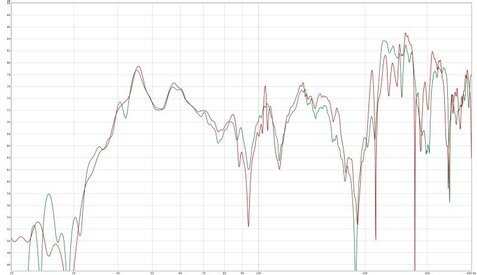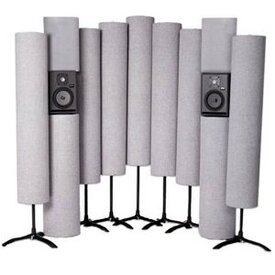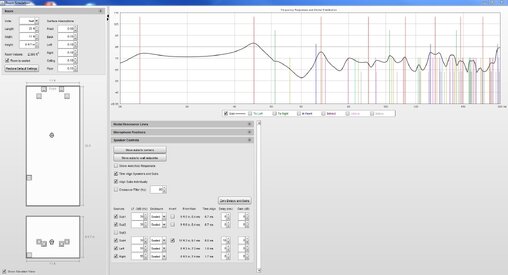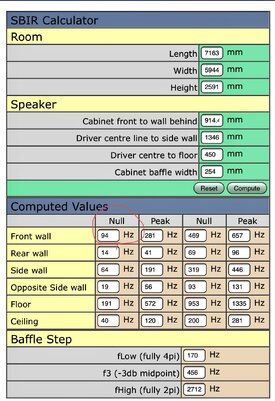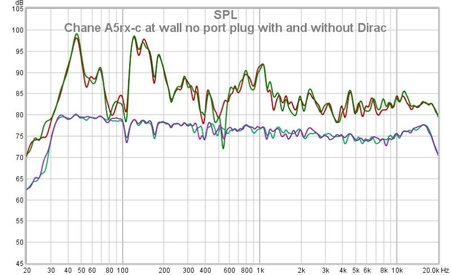Looking for some advise for my small listening room. The focus of this room is a critical listening environment.
This is currently an untreated room. Walls and ceiling are sheetrock, floors are hardwood on a suspended floor with an area rug/pad on top.
Equipment: MacBook Air + REW 5.19 b7a
Room: 11' W x 12' 4" L x 10' H
Speakers: Decware HR-1 Hybrid Radial
- 92.5 dB with 1 watt at 1 meter
- 32Hz ~ 22kHz
- 6 inch radial driver
- 6 inch mid-range driver
- 4 inch ribbon planar tweeter
- 8 inch passive radiator
View attachment 4808 View attachment 4809
It looks like there are a few issues. I won't interpret anything up high until I see your new measurements in case that is an artifact. I see what looks like comb filtering up high.
Down low it looks like you have significant SBIR cancelation. I would consider two options to address that. First is a different speaker location. However just to be sure of what we are looking at, can you take more measurements at multiple locations at least 24" apart? I would also take at least one measurement at a higher elevation and one at a lower elevation. Your room ratio places the room modes so close together that I want to be sure that I am seeing SBIR (Which won't change with mic position, or modes (which will), or both.
Your room ratio is 1:1.1:1.22, and if you.go here you will see that this is a tough ratio of dimensions for bass eveness.
http://www.acoustics.salford.ac.uk/acoustics_info/room_sizing/?content=best
Is your listening position dead center of the room or very close to it? If so it would be a good idea to move it some. Different placement of you and the speakers may help reduce that null.
I would also consider treatments to help but the bass null is so low that most panels won't do much. It's also a very small space and so the general advice is more absorption and a lower RT60 than is preferable in a larger space. My suggestion is to consider bass traps covering most if not all of the front wall behind the speakers.
Normally I suggest a range of treatments to avoid making an uneven RT60 and overly dry space. In spaces like you have (my last listening space was similar to this but with lower ceilings), I find you need a lot more dedicated bass traps to get things smoothed out and sounding better.
If you are a DIYer, feel free to diy. If not, please choose whoever you like and don't feel like these recomendations are seeking to sell you on anything (I don't work for Gik). However since I know Giks lineup well I will share my suggested treatment plan.
Front wall: four monster bass traps consider using two range limited and two full range. If you can handle six, that's better and I might suggest 4 as full range.
http://www.gikacoustics.com/product/gik-acoustics-monster-bass-trap-flexrange-technology/
Front corners: four soffit traps
http://www.gikacoustics.com/product/gik-acoustics-soffit-bass-trap/
Ceiling: four 24"x48" 6A alpha panels with 1D diffussion. You could go with 2D if you want but in small spaces with a set listening position it's not as valuable. It is preferable to mount these as a cloud which will extend the Lf absorption.
Side walls: two to three 24x48 panels of 6" depth. I would use either the Monster bass trap or 6A alpha again. You could use a 242 panel to save money but remember you need a lot of bass trapping. The 242 doesn't offer a lot of bass trapping, but this side location is less critical than the front, rear, and ceiling.
Rear wall: two or more monster bass traps range limited. If you have the ability, soffit traps or corner traps in the rear are also good. As crazy as it sounds, covering nearly the entire rear wall with bass trapping can be beneficial in small spaces. It absorbs the bass wave hitting the rear wall and reduces the impact of length axial modes.
If you know you like a lively room feel free to use more of the 6A alpha panels, but know you lose some bass trapping which you need. Because you are trying to address SBIR caused by the front wall and ceiling, the front wall is most important to treat with bass trap panels.
With omni-Radiation pattern speakers it's good to know that this treatment approach is going to absorb much of their reflections. You could add diffussers between the speakers or at the side wall, but I worry you will lose needed bass trapping.
As with anything in audio, you don't have to do this all at once. If I had to prioritize I would do the wall behind the speakers and side walls first. You could do less than I suggested to start, the results just won't be as dramatic.










